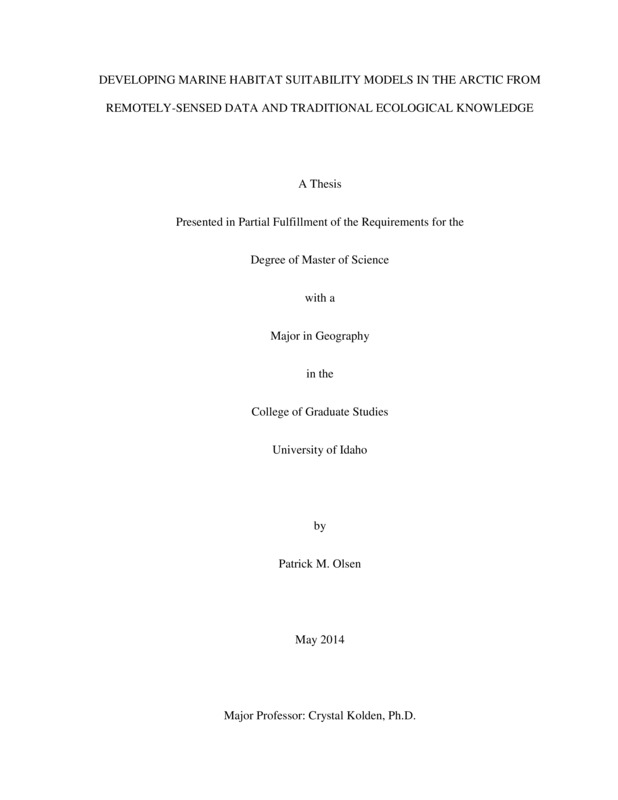Developing Marine Habitat Suitability Models In The Arctic From Remotely-Sensed Data And Traditional Ecological Knowledge
Olsen, Patrick Mark. (2014). Developing Marine Habitat Suitability Models In The Arctic From Remotely-Sensed Data And Traditional Ecological Knowledge. Theses and Dissertations Collection, University of Idaho Library Digital Collections. https://www.lib.uidaho.edu/digital/etd/items/olsen_idaho_0089m_10298.html
- Title:
- Developing Marine Habitat Suitability Models In The Arctic From Remotely-Sensed Data And Traditional Ecological Knowledge
- Author:
- Olsen, Patrick Mark
- Date:
- 2014
- Keywords:
- marine mammal habitat MODIS remote sensing time series traditional ecological knowledge
- Program:
- Geography
- Subject Category:
- Remote sensing; Native American studies; Ecology
- Abstract:
-
Arctic environments have been experiencing dramatic shifts in climate over the past several decades in both terrestrial and marine settings. As the Arctic sea ice thins and covers less area each year, mineral and oil exploration and other marine transport traffic is increasing; development poses potential threats to the habitat and ecosystem of the Bering Strait and the humans whose subsistence depends on healthy marine mammal populations. There is a lack of information regarding critical habitat for many marine species, including the bearded seal, an important source of protein for the indigenous hunters of Bering Strait. This information gap inhibits marine spatial planning and conservation efforts in the region. An objective approach to modeling marine mammal habitat in polar regions using Traditional Ecological Knowledge (TEK) of Alaskan Native hunters is developed to address the gap. The approach substitutes lifetime and cross-generational knowledge of subsistence hunters and their harvest data for observational knowledge gained from formal scientific field surveys of marine mammal sightings. TEK was transformed to seal presence/absence and used to train Classification Tree Analyses (CTA) of environmental predictor variables to predict suitable habitat for bearded seal in Bering Strait. Predictor data included MODIS Aqua data products between 2003 and 2012, and bathymetric data and distance data. CTA analyses were conducted at 15 different levels of training and validation points for both time series (TS) and non-time series (NTS) predictor variable series at 4km spatial resolution. The TS and NTS series produced similar maps of bearded seal suitable habitat, with the TS maps consistently predicting more suitable habitat. Although identified as one of the "ice seal" species, the modeling did not demonstrate that sea ice is critical for predicting bearded seal suitable habitat. A Kappa of 0.883 was achieved for both TS and NTS classifications, while the TS predictor set selected more area as bearded seal habitat than the NTS predictor set. The TEK information used is spatially restricted, provides a viable, replicable alternative when scientific observational data is limited or non-existent.
- Description:
- masters, M.S., Geography -- University of Idaho - College of Graduate Studies, 2014
- Major Professor:
- Abatzoglou, Crystal
- Committee:
- Humes, Karen; Ray, Lily
- Defense Date:
- 2014
- Identifier:
- Olsen_idaho_0089M_10298
- Type:
- Text
- Format Original:
- Format:
- application/pdf
- Rights:
- In Copyright - Educational Use Permitted. For more information, please contact University of Idaho Library Special Collections and Archives Department at libspec@uidaho.edu.
- Standardized Rights:
- http://rightsstatements.org/vocab/InC-EDU/1.0/

